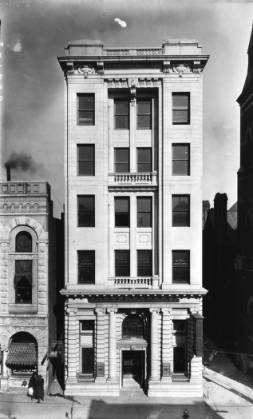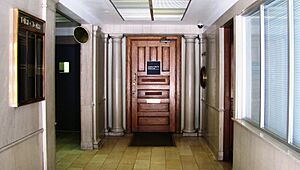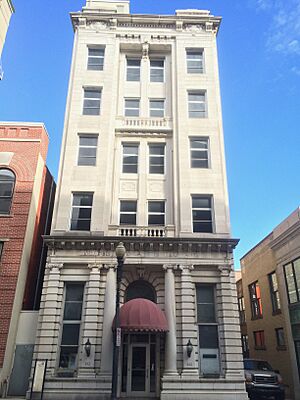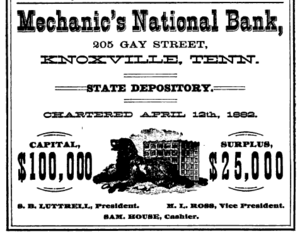Mechanics' Bank and Trust Company Building facts for kids
Quick facts for kids |
|
|
Mechanics' Bank and Trust Company Building
|
|
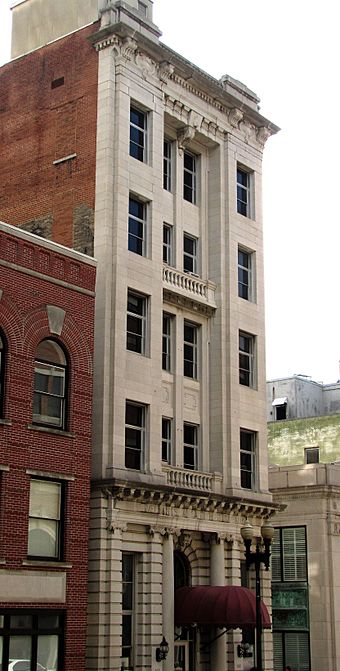
Gay Street facade
|
|
| Location | 612 S. Gay St., Knoxville, Tennessee |
|---|---|
| Area | .5 acres (2,000 m2) |
| Built | 1907, expanded 1923 |
| Architectural style | Second Renaissance Revival (influences) |
| NRHP reference No. | 83003043 |
| Added to NRHP | January 27, 1983 |
The Mechanics' Bank and Trust Company Building is an office building in Knoxville, Tennessee. You can find it at 612 South Gay Street. It was built in 1907 for the Mechanics' Bank and Trust Company. Today, it holds offices for law firms and financial groups.
The building's front, called its facade, is made from marble found right here in Tennessee. Its design is inspired by the Second Renaissance Revival style. This style brings back ideas from the Renaissance period, like grand, balanced shapes. In 1983, the building was added to the National Register of Historic Places. This means it's an important historical site because of its special design.
The Mechanics' National Bank started in 1882. It moved into a building at 612 South Gay Street that same year. A few months later, the bank's president, Thomas O'Connor, was killed in a famous incident. In 1907, the bank changed its name to Mechanics' Bank and Trust. It then built the first three floors of the building you see today. Another bank, Union National Bank, took over Mechanics' Bank in 1922. They added the top two stories the next year. Later, a branch of the Hamilton National Bank was in the building. In the early 1980s, the building housed the City and County Bank. This bank faced serious financial problems and closed down in 1983.
Contents
Building Design
The Mechanics' Bank building is a tall, rectangular building with six levels. It is about 145 feet (44 meters) long and 32 feet (9.8 meters) wide. The front of the building, facing Gay Street, is made of beautiful Tennessee marble. The sides and back are built with brick and strong concrete.
The building first had three main floors and a mezzanine (a floor between two main floors). In 1923, two more floors were added. The builders made sure these new floors matched the original design perfectly. An elevator room was added to the roof much later.
Architectural Style
The design of the Mechanics' Bank building comes from the Second Renaissance Revival style. This style often uses grand, classical elements. For example, the main floor has six Ionic capitals. These are decorative tops for columns, shaped like scrolls. The two middle capitals sit on marble columns that frame the main entrance.
A large, decorative ledge, called a cornice, separates the main floor from the upper floors. The main entrance is a tall archway with a pointed top, called a pediment. The middle part of the upper floors is set back a bit. It has decorative railings, called balustrades, between the first and second floors, and the third and fourth floors. Above the top floor, there's another stylish cornice. It features a special symbol: an arm-and-hammer symbol. This was the symbol for the Mechanics' Bank.
Inside the Building
The inside of the building has been changed a lot over the years. However, some original parts are still there. The entrance foyer (a large hall) has pink marble walls. Two marble columns stand on either side of the lobby's main entrance. The lobby itself still has some original marble wainscoting (wood or paneling on the lower part of a wall) and plaster beams. Nine columns line the two-story lobby of the first floor. It also has fancy crown molding and a large mezzanine above where the bank vault used to be. This area has been updated and is now used as a kitchen.
Building History
The land where the Mechanics' Bank building stands was once part of a property set aside for Blount College. This college is now the University of Tennessee. The Bank of Tennessee was the first bank on this spot in the early 1800s. During the American Civil War, the bank's building was used as an office by the Union Army. Later, other banks like First National Bank and East Tennessee National Bank used the site.
Mechanics' Bank and Trust Story
In 1882, the East Tennessee National Bank moved out. The Mechanics' National Bank, which had just started, moved into the old building at 612 Gay Street. The bank's first leaders included Thomas O'Connor as president. In October 1882, O'Connor was killed in a well-known incident that happened right in front of the bank. This event, where others were also killed, made national news. It was even mentioned in Mark Twain's famous book, Life on the Mississippi.
After O'Connor's death, Samuel B. Luttrell became president in 1883. He stayed president for many years. In 1900, a book about Knoxville said the bank was doing very well.
In 1907, Mechanics' National Bank changed its name to Mechanics' Bank and Trust Company. This is when they built the current building. Mechanics' Bank was later taken over by Union National Bank in 1922. Union National then added the building's two top floors in 1923. Another bank, Holston-Union National Bank, took over Union National in 1928. After Holston-Union closed in 1930, the Hamilton National Bank opened a branch in the Mechanics' Bank building for many decades.
Recent Times
In the 1950s, the top floor of the Mechanics' Bank building was home to the studios of radio station WROL-AM. This station was famous for its host, Cas Walker. The Everly Brothers, a very popular music group, often performed there during that time.
In the 1970s, a banking business owner named Jake Butcher gained control of Hamilton National Bank. He changed its name to United American Bank. The Mechanics' Bank building then became a branch of the City and County Bank, led by Butcher's brother. In 1983, after federal investigators found problems with the Butcher brothers' banks, the City and County Bank and other related banks closed down. Since then, the building has been updated and is now used for various offices.


